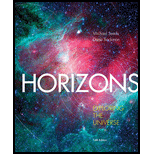
Horizons: Exploring the Universe (MindTap Course List)
14th Edition
ISBN: 9781305960961
Author: Michael A. Seeds, Dana Backman
Publisher: Cengage Learning
expand_more
expand_more
format_list_bulleted
Textbook Question
Chapter 3, Problem 1RQ
What is the difference between the daily and annual motions of the Sun?
Expert Solution & Answer
To determine
The difference between the daily and annual motions of the Sun
Answer to Problem 1RQ
The difference between daily and annual motions of Sun is their occurrence and direction.
Explanation of Solution
As we know that Earth`s rotation from East to West is the cause of daily motion of Sun.
The annual motion of the sun is from Earth`s orbit around the Sun combined with Earth`s tilted axis of rotation. This motion is from north to south.
The difference between daily and annual motions of Sun is their occurrence and direction.
Want to see more full solutions like this?
Subscribe now to access step-by-step solutions to millions of textbook problems written by subject matter experts!
Students have asked these similar questions
3
Set
ба
||Axl
49.32
6b
71
Ay
22
Magnitude of A
Angle of A
24.04
Angle of -A
22
54
155.96
° (pos Ax) 204.04
° (neg Ax) 335.96
°
(pos Ax)
° (neg Ax)
115.77
° (pos Ax) 295.77
° (pos Ax)
-39
81
208.78
° (neg Ax) 28.78
°
(neg Ax)
3AA . not sure what i am getting wrong
Chapter 3 Solutions
Horizons: Exploring the Universe (MindTap Course List)
Ch. 3 - What is the difference between the daily and...Ch. 3 - If Earth did not rotate, could you still define...Ch. 3 - What would the seasons be like if Earth were...Ch. 3 - Why are the seasons reversed in the Southern...Ch. 3 - Prob. 5RQCh. 3 - Do the phases of the Moon look the same from every...Ch. 3 - What phase would Earth be in if you were on the...Ch. 3 - Why have most people seen a total lunar eclipse,...Ch. 3 - Why isn’t there an eclipse at every new moon and...Ch. 3 - Why is the Moon red during a total lunar eclipse?
Ch. 3 - Why should the eccentricity of Earth’s orbit make...Ch. 3 - Prob. 12RQCh. 3 - Prob. 13RQCh. 3 - How Do We know? Why must a scientific argument...Ch. 3 - You are packing for a vacation on a planet...Ch. 3 - You happen to visit the Moon when some people on...Ch. 3 - Given that Earth is about 4.6 billion (4.6109)...Ch. 3 - Identify the phases of the Moon if on March 20 the...Ch. 3 - Identify the phases of the Moon if at sunset in...Ch. 3 - Prob. 4PCh. 3 - Draw a diagram showing Earth, the Moon, and...Ch. 3 - Phobos, one of the moons of Mars, is about 25 km...Ch. 3 - A total eclipse of the Sun was visible from Canada...Ch. 3 - Prob. 8PCh. 3 - The cartoon in Figure UN 3-4 shows a crescent...Ch. 3 - The photo in Figure UN 3-5 shows the annular...
Knowledge Booster
Learn more about
Need a deep-dive on the concept behind this application? Look no further. Learn more about this topic, physics and related others by exploring similar questions and additional content below.Similar questions
arrow_back_ios
SEE MORE QUESTIONS
arrow_forward_ios
Recommended textbooks for you
 An Introduction to Physical SciencePhysicsISBN:9781305079137Author:James Shipman, Jerry D. Wilson, Charles A. Higgins, Omar TorresPublisher:Cengage Learning
An Introduction to Physical SciencePhysicsISBN:9781305079137Author:James Shipman, Jerry D. Wilson, Charles A. Higgins, Omar TorresPublisher:Cengage Learning AstronomyPhysicsISBN:9781938168284Author:Andrew Fraknoi; David Morrison; Sidney C. WolffPublisher:OpenStax
AstronomyPhysicsISBN:9781938168284Author:Andrew Fraknoi; David Morrison; Sidney C. WolffPublisher:OpenStax Foundations of Astronomy (MindTap Course List)PhysicsISBN:9781337399920Author:Michael A. Seeds, Dana BackmanPublisher:Cengage Learning
Foundations of Astronomy (MindTap Course List)PhysicsISBN:9781337399920Author:Michael A. Seeds, Dana BackmanPublisher:Cengage Learning Stars and Galaxies (MindTap Course List)PhysicsISBN:9781337399944Author:Michael A. SeedsPublisher:Cengage Learning
Stars and Galaxies (MindTap Course List)PhysicsISBN:9781337399944Author:Michael A. SeedsPublisher:Cengage Learning


An Introduction to Physical Science
Physics
ISBN:9781305079137
Author:James Shipman, Jerry D. Wilson, Charles A. Higgins, Omar Torres
Publisher:Cengage Learning

Astronomy
Physics
ISBN:9781938168284
Author:Andrew Fraknoi; David Morrison; Sidney C. Wolff
Publisher:OpenStax

Foundations of Astronomy (MindTap Course List)
Physics
ISBN:9781337399920
Author:Michael A. Seeds, Dana Backman
Publisher:Cengage Learning

Stars and Galaxies (MindTap Course List)
Physics
ISBN:9781337399944
Author:Michael A. Seeds
Publisher:Cengage Learning


Time Dilation - Einstein's Theory Of Relativity Explained!; Author: Science ABC;https://www.youtube.com/watch?v=yuD34tEpRFw;License: Standard YouTube License, CC-BY